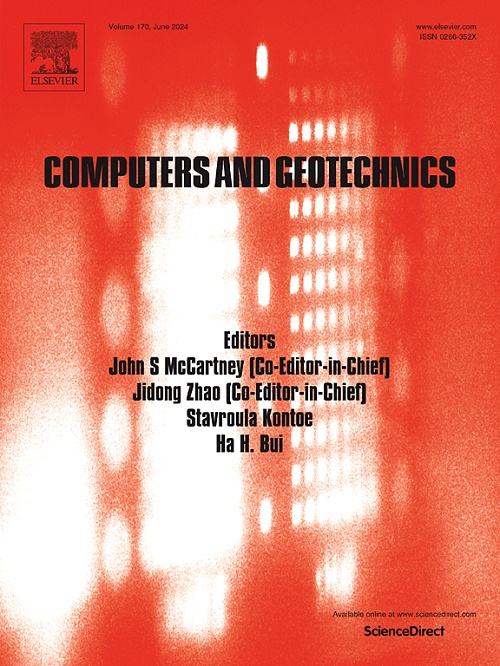脆性岩石变形和断裂的随时间变化的微平面模型
IF 5.3
1区 工程技术
Q1 COMPUTER SCIENCE, INTERDISCIPLINARY APPLICATIONS
引用次数: 0
摘要
更全面地了解脆性岩石的渐进、随时间变化的变形和破裂对于评估工程结构周围岩体的长期完整性至关重要。在这项研究中,我们提出了一个集成微平面模型和亚临界裂纹扩展的三维数值模型来研究脆性岩石的渐进、随时间的变形和破裂。该模型将亚临界裂纹扩展和随时间变化的损伤演化本构规律纳入微平面。该模型通过跟踪以往研究中观察到的亚临界裂纹扩展趋势,准确地捕捉了虚拟裂纹随时间的扩展。微平面上的应变和损伤演化之间的协同相互作用最终导致材料在长时间内局部退化。该模型有效表征了脆性岩石随时间变形和破裂过程中损伤单元的时空分布特征。数值模拟成功地复制了在脆性岩石进行的实验室实验中观察到的现象。具体来说,他们展示了不同的应力水平如何影响蠕变应变率和失效时间。此外,模拟结果还表明,潜在裂纹(微面)的微尺度相互作用可以有效地描述脆性岩石复杂的宏观时变行为。因此,可以使用基于实验室测试的校准模型来预测失效时间和破裂模式。所提出的数值模型在预测大型岩体的长期稳定性方面具有进一步推广的潜力。本文章由计算机程序翻译,如有差异,请以英文原文为准。
A time-dependent microplane model for deformation and fracturing of brittle rock
A more comprehensive understanding of the progressive, time-dependent deformation and fracturing of brittle rock is crucial for assessing the long-term integrity of rock masses surrounding engineering structures. In this study, we propose a three-dimensional numerical model that integrates the microplane model and subcritical crack growth to investigate the progressive, time-dependent deformation and fracturing of brittle rock. The model incorporates subcritical crack growth and time-dependent damage evolution constitutive laws into the microplanes. By following the trend of subcritical crack growth observed in previous studies, the model accurately captures the time-dependent propagation of virtual cracks. The cooperative interaction between strain and damage evolution on the microplanes ultimately leads to localized material degeneration over extended time. Moreover, this model effectively characterizes the temporal and spatial distribution of damaged elements during time-dependent deformation and fracturing of brittle rock. The numerical simulations successfully replicate phenomena observed in laboratory experiments performed on brittle rock. Specifically, they demonstrate how different stress levels influence creep strain rate and time-to-failure. Additionally, the simulations reveal that the microscale interaction of potential cracks (microplanes) can effectively describe the complex macroscopic time-dependent behavior of brittle rock. As a result, it becomes possible to predict time-to-failure and rupture patterns using the calibrated model based on laboratory tests. The proposed numerical model holds the potential to be further extended for predicting the long-term stability of larger rock masses.
求助全文
通过发布文献求助,成功后即可免费获取论文全文。
去求助
来源期刊

Computers and Geotechnics
地学-地球科学综合
CiteScore
9.10
自引率
15.10%
发文量
438
审稿时长
45 days
期刊介绍:
The use of computers is firmly established in geotechnical engineering and continues to grow rapidly in both engineering practice and academe. The development of advanced numerical techniques and constitutive modeling, in conjunction with rapid developments in computer hardware, enables problems to be tackled that were unthinkable even a few years ago. Computers and Geotechnics provides an up-to-date reference for engineers and researchers engaged in computer aided analysis and research in geotechnical engineering. The journal is intended for an expeditious dissemination of advanced computer applications across a broad range of geotechnical topics. Contributions on advances in numerical algorithms, computer implementation of new constitutive models and probabilistic methods are especially encouraged.
 求助内容:
求助内容: 应助结果提醒方式:
应助结果提醒方式:


